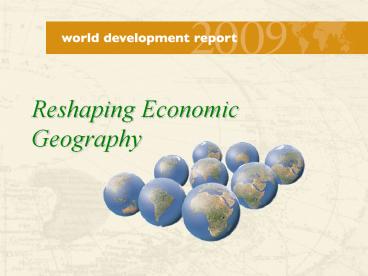Reshaping Economic Geography - PowerPoint PPT Presentation
1 / 34
Title:
Reshaping Economic Geography
Description:
35 million out of 120 million Japanese, packed into 4 percent of ... Train-packers needed. People die every day on Mumbai's trains. 17. Going to work in China ... – PowerPoint PPT presentation
Number of Views:35
Avg rating:3.0/5.0
Title: Reshaping Economic Geography
1
Reshaping Economic Geography
2
Three Special Places
- Tokyothe biggest city in the world
- 35 million out of 120 million Japanese, packed
into 4 percent of Japans land area - USAthe most mobile country
- More than 35 million out of 300 million changed
residence in 2006 8 million people changed
states - West Europethe most integrated continent
- About 35 percent of its GDP is traded, almost two
thirds within the region
3
Crowded cities
Tokyos trains have been moving 8 million people
every day
4
Packing in the subways
Tokyos trainpackers crush commuters into
metrorail carriages
5
And piling up wealththe fruits of proximity
Japans economic mass is concentrated in the
Tokyo-Yokohama area
6
How East Asia stacks up
7
Going home for the holidays
Planes in the air on the Tuesday before
Thanksgiving in the US
8
Going home for the holidays?
Stranded by storms before the Thanksgiving weekend
9
Why Americans put up with the pain of moving
Economic mass is concentrated in a few parts of a
big country
10
Specializing and trading in Western Europe
Airbus parts are made, moved, and assembled all
over Western Europe
11
Loading and moving the fruits of specialization
Airbus parts are made, moved, and assembled all
over Western Europe
12
Made possible by a slow and painful integration
Thin borders in Europe, thick in Africa
13
The result?
The US, EU-15, and Japan cover much of the
economic globe
14
Stories being repeated now in developing Asia
- Mumbaithe most densely populated city
- About 30,000 people per sq. km. already twice
the population density of Seoul, Shanghai, and
Bogotá - Chinathe most mobile developing country
- 60 million migrant workers traveled from home on
the last day of Chinese New Year holidays in 2006 - 200 million travelers were stranded due to snow
storms days before Chinese New Year in 2008 - Southeast Asiathe most rapidly integrating
developing region - Trade is a big part of GDP
- More than 25 percent of its trade is within
Southeast Asia more than 50 percent if Northeast
Asia is included
15
Stuffed trains in Mumbai
Mumbais trains move 6 million people every day
16
Train-packers needed
People die every day on Mumbais trains
17
Going to work in China
Millions of Chinese workers migrated despite
restrictions in the 1990s
18
Going home in China
Guangzhou railway station during Chinese New
Year, 2008
19
Specialization and trade in Southeast Asia
Computer parts are made and assembled all over
East Asia
20
The result?
China, Southeast Asia, and India can again be
recognized on a map of the worlds economic
geography
21
Geographic transformations needed for progress
- Higher Densities
- No country has grown to high income without
urbanizing - Shorter Distances
- Growth seldom comes without the need to move
closer to density - Fewer Divisions
- Growth seldom comes to a place that is isolated
from others
22
Report structure
23
Geographic scales
The report examines policy issues at the local,
national and international geographic scales
24
Policy concernsat each geographic scale
- Local Concentration of people in cities will
outstrip concentration of economic mass - A billion people in the worlds slums
- National Geographic disparities in living
standards will widen as economic mass
concentrates in leading provinces - A billion people in remote and lagging areas
- International Poor people will be trapped in
isolated countries that are not developing - The new Third World Colliers Bottom Billion
25
WDR 2009 messages
- Growth will be unbalanced
- Trying to spread out economic production amounts
to fighting the forces of economic growth - Development can still be inclusive
- Persistent spatial disparities in basic living
standards are neither desirable nor inevitable - How to get both unbalanced growth and inclusive
development? Economic integration - Changing debates on urbanization, regional
development, and global integration from spatial
targeting to spatial integration
26
Calibrating integration policiesan I for a D
27
Incipient, intermediate and advanced urbanization
present different policy challenges
Locally, as urbanization advances, the dimensions
of the integration challenge increase
Encouraging density, reducing distance, and
lowering divisions around Bogota, Colombia
Encouraging density and reducing distance in
Bucaramanga, Colombia
Encouraging density in Popayan, Colombia
Orange areas denote urban settlementsPopayan,
Bucaramanga, and Bogota
28
1DChina Lagging areas have high poverty rates,
but leading areas have most of the poor
Nationally, the dimensioneconomic distance the
instrumentinstitutions that unify
29
2DBrazil Lagging areas have high poverty rates
and many of the poor
The dimensionslong distances and misplaced
densities the instrumentsinstitutions, and
infrastructure to connect leading and lagging
places
30
3DIndia, lagging areas have high poverty rates
and a big share of the poor
The dimensionslong distances, misplaced
densities, and domestic divisions the
instrumentsinstitutions, infrastructure, and
incentives that target
31
Market access helps to classify the developing
worlds neighborhoods
Internationally, the three dimensions can be used
to characterize the difficulty of integration for
countries in different parts of the world
32
Calibrating integration policiesan I for a D
33
What the report proposes
- Understand the spatial transformations necessary
for progress - Higher Densities, shorter Distances, and fewer
Divisions - Unleash the market forces that promote economic
concentration and social convergence - Agglomeration, Migration, and Specialization
- Calibrate policies to economic geography of
places - Institutions which unitehelping labor and
capital move to opportunity - Infrastructure to connectbut do not expect
production to spread out - Interventions that targetbut only where
necessary - The result unbalanced growth, inclusive
development
34
For more information
- www.worldbank.org/wdr2009
- cgoh_at_worldbank.org
- scoulibaly2_at_worldbank.org
- tpackard_at_worldbank.org
- udeichmann_at_worldbank.org
- igill_at_worldbank.org
- mtuck_at_worldbank.org

